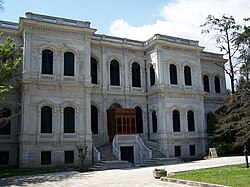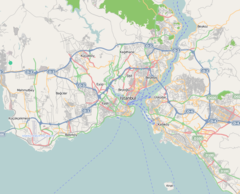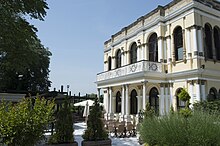| Yıldız Palace | |
|---|---|
 Yıldız Palace, Büyük Mabeyn Köşkü Yıldız Palace, Büyük Mabeyn Köşkü | |
 | |
| General information | |
| Type | Palace |
| Location | Istanbul, Turkey |
| Coordinates | 41°02′58″N 29°00′40″E / 41.04944°N 29.01111°E / 41.04944; 29.01111 |
| Completed | 1880 |
| Client | Ottoman imperial family |
| Website | |
| http://yildizsarayi.com.tr | |

Yıldız Palace (Turkish: Yıldız Sarayı, IPA: [jɯɫˈdɯz saɾaˈjɯ]) is a vast complex of former imperial Ottoman pavilions and villas in Beşiktaş, Istanbul, Turkey, built in the 19th and early 20th centuries. It was used as a residence by the sultan and his court in the late 19th century.
Origin
Yıldız Palace, meaning "Star Palace", was built in 1880 and was used by the Ottoman Sultan Abdülhamid II. The area of the palace was originally made of natural woodlands and became an imperial estate during the reign of Sultan Ahmed I (r. 1603–1617). Various sultans after Ahmed I enjoyed vacationing on these lands and Sultans Abdülmecid I and Abdülaziz built mansions here. The Yildiz Palace was a complex over a large area of hills and valleys. This was an example of traditional Ottoman architecture consisting of a complex of different buildings across a piece of land.
The first pavilion was built by Sultan Selim III from 1798 to 1808, for his mother, Mihrişah Sultan. In the 1870s, the surrounding area of the palaces were a series of isolated pavilions in a wooded setting.
In the late 19th century, Sultan Abdülhamid II left Dolmabahçe Palace because he feared a seaside attack on the palace, which is located at the shore of the Bosporus strait. He expanded the Yıldız Palace and ordered the renowned Italian architect Raimondo D'Aronco to build new buildings to the palace complex. When he moved there, the palace became the fourth seat of Ottoman government (the previous ones were the Eski Saray (Old Palace) in Edirne, and the Topkapı Palace and Dolmabahçe Palaces in Istanbul.
Layout
The palace is a complex of buildings including the State Apartments Büyük Mabeyn, Şale Pavilion, the Malta Pavilion, the Çadır Pavilion, the Yıldız Theater and Opera House, the Yıldız Palace Museum, and the Imperial Porcelain Factory. The Yıldız Palace Gardens are also a popular public site among the residents of Istanbul. A bridge connects the Yıldız Palace with the Çırağan Palace on the Bosporus through this garden.
The Yıldız Palace is separated into three courtyards. The first courtyard is where the Sultan and his leaders would govern, which makes sense because the palace served as the fourth seat of Ottoman government. In this courtyard, one may find offices for governing officials, the extensive library of Sultan Abdulhamid II, and an armory. In the second courtyard was the private living area for the Sultan and his family. The third courtyard was where the outer gardens were. These gardens included some of the rarest plants and flowers at the request of Sultan Abdulhamid II. Also, the third courtyard is where the Yıldız Tile Factory was located as well. There, the Ottomans created tiles and other forms of art like vases from porcelain.

Büyük Mabeyn Kiosk
Büyük Mabeyn Köşkü was built by Sultan Abdülaziz in 1866 and designed by court architect Sarkis Balyan. It was one of the main residences of Sultan Abdülhamid II at Yıldız Palace, together with the Şale Köşkü. Sultan Abdülhamid II hosted foreign visitors at this building, including Rudolf, Crown Prince of Austria and his wife Princess Stéphanie of Belgium in 1884, and Kaiser Wilhelm II of the German Empire in 1889. Büyük Mabeyn Köşkü is no longer open to the public and is no longer a museum. Since 2015, it is used by the President of Turkey during his visits to Istanbul, along with his offices at the Dolmabahçe Palace and the Vahdettin Pavilion.
State apartments

Government officials working for Sultan Abdülhamid II had their offices at the State Apartments building (Turkish: Yaveran ve Bendegân Dairesi). The Istanbul office of the OIC is currently located within this building.
Şale Kiosk


Sultan Abdülhamid II's other main residence inside the Yıldız Palace complex was the Şale Kiosk (Şale Pavilion, Turkish: Şale Köşkü). The building has two floors and a basement, and is constructed from a mix of wood and stone. It was constructed in three phases, with the first two parts (built with wood in 1877–1879 and 1889) designed by court architect Sarkis Balyan, and the third part (built with stone masonry in 1898) designed by court architect Raimondo D'Aronco. The first part was designed to resemble a Swiss chalet, hence the name Şale. Winston Churchill and Charles de Gaulle were among the visitors to this part of the palace. The second part was added in 1889 to accommodate Kaiser Wilhelm II, who was the first foreign monarch to visit Constantinople. It was during this phase that the Sedefli Salon (Mother-of-Pearl Hall) was added. The name derives from the extensive use of mother-of-pearl that covered almost all of its surfaces. There are also detailed painted landscapes on the ceiling. The third part of the Şale Kiosk was also built for Kaiser Wilhelm II, for his second visit in 1898 (the Kaiser's third visit to the city was in 1917, during the reign of Sultan Mehmed V). The reception chamber was built during this period and remains the most impressive room in the entire Şale Pavilion. There is a single carpet on the floor that has an area greater than 400 square meters and was hand woven by 60 weavers. Elegant features of the chamber include a gilded, coffered ceiling and large mirrors. Sultan Abdülhamid II was a skilled carpenter and actually made some of the pieces of furniture that can be viewed inside the Şale Pavilion.
Malta Kiosk
Main article: Malta Kiosk
The Malta Kiosk, designed by the court architect Sarkis Balyan, is a pavilion located in Yıldız Park to the north side of the wall separating Yıldız Palace. There are also two watching and resting pavilions in the grove being the rear garden of Çırağan Palace dating from the reign of Sultan Abdülaziz. The origin of the name comes from the extensive use of limestone from Malta, which is the prominent material used.
The trial of Midhat Pasha took place in a tent behind the pavilion.
Çadır Kiosk

It was built by Sultan Abdülaziz (1861–76), who used them as prisons. Today it houses a café and restaurant.
Yıldız Theatre and Opera House
Built by Sultan Abdülhamid II in 1889, it has stars on its domed ceiling, a reference to the name of the Yıldız Palace, which means Star Palace. Because no one was allowed to have his back to the sultan, the position of the sultan's balcony box meant that the first row seats were never used.
Yıldız Palace Museum
This used to be Sultan Abdülhamid II's carpentry workshop who was influenced for carpentry by Prophet Hadhrat Nuh A.S and is now used to display art and objects from the palace.
Imperial Porcelain Factory

Opened in 1895, the factory was constructed to meet the demand of the upper classes for European-style ceramics. The bowls, vases and plates it produced often pictured idealized scenes of the Bosphorus. The building has an interesting appearance in that it resembles a European medieval castle.
Later use
After the Ottoman Empire ended, the palace was used as a luxury casino before being converted into a guest house for visiting heads of state and royalty. It later became a museum and its gardens could be used for private receptions and events, such as the Istanbul Antiques Fair which used to take place at the Silahhane (Armoury) Hall.
See also
References
- "The luxurious palaces of the Ottoman Empire". DailySabah. Retrieved 2018-01-22.
- "Yildiz Palace". Istanbul View. 2014-03-25. Retrieved 2021-12-07.
- ^ "Yıldız Palace Complex". UNESCO World Heritage Centre. Retrieved 2021-12-07.
- Freely, John (1998). Istanbul : the imperial city. Internet Archive. London; New York: Penguin Books. p. 281. ISBN 978-0-14-024461-8.
- "Istanbul's Yıldız Palace 'allocated' for Turkish president - Turkey News". Hürriyet Daily News. 8 November 2015.
- "Cumhurbaşkanı Erdoğan, Almanya Başbakanı Merkel'i Kabul Etti". tccb.gov.tr. 18 October 2015.
- "Dolmabahçe Çalışma Ofisi'nde güvenlik toplantısı". tccb.gov.tr. 13 January 2024.
- "Cumhurbaşkanı Erdoğan, İngiltere Dışişleri Bakanı Cameron'u kabul etti". tccb.gov.tr. 26 January 2024.
- Ö. Kürşad Karacagil (2014). "WILHELM II'S VISIT TO THE OTTOMAN EMPIRE AND THE DIARY OF HIS HOST MEHMED SHAKIR PASHA (1898)". Journal of Turkology. Istanbul University Press. pp. 73–97. doi:10.18345/tm.52503.
- Ellul, Michael (2010). "Malta Limestone goes to Europe: Use of Malta Stone outside Malta". In Joseph F. Grima (ed.). 60th anniversary of the Malta Historical Society: a commemoration. Zabbar: Veritas Press. pp. 371–406. ISBN 978-99932-0-942-3. OCLC 779340904. Archived from the original on 25 March 2019.
Literature
- Önder Küçükerman, Nedret Bayraktar, Semra Karakaţli. Yıldız Porcelain in National Palaces Collection. TBMM, Istanbul, 1998.
- Vahide Gezgör, Feryal Irez. Yıldız Palace Chalet Kasr-ı Hümayunu. TBMM, Istanbul, 1993.
External links
- Directorate of National Palaces: Yıldız Palace website
- Picture gallery of park and palace
- Eyewitness Travel Guides: Istanbul. 124-125
- Points from Turkey
| Beşiktaş, Istanbul | |||||
|---|---|---|---|---|---|
| Neighbourhoods | |||||
| Quarters | |||||
| Education |
| ||||
| Landmarks | |||||
| Metro Stations |
| ||||
| History | |||||
| Reign of Abdul Hamid II | ||
|---|---|---|
| Major events |  | |
| Associated buildings | ||
| Wars | ||
| Family |
| |
| Wives | ||
